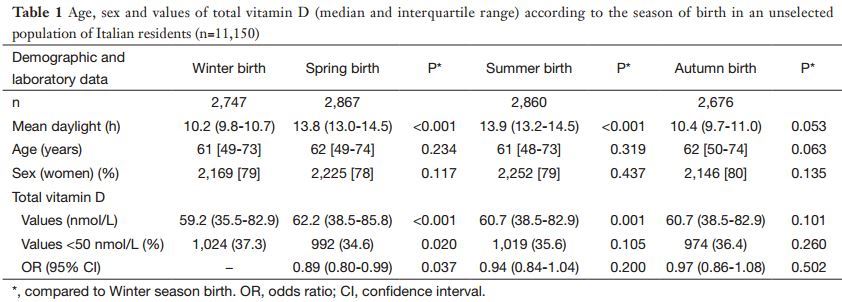If born in the winter, 11 percent more likely to be vitamin D deficient as an adult
Birth season and vitamin D concentration in adulthood
Annals of Translational Medicine, Vol 3, No 16 (September 2015) doi: 10.3978/j.issn.2305-5839.2015.09.30
Giuseppe Lippi glippi@ao.pr.it, Patrizia Bonelli, Ruggero Buonocore, Rosalia Aloe
Laboratory of Clinical Chemistry and Hematology, Academic Hospital of Parma, Parma, Italy
Contributions: (I) Conception and design: G Lippi; (II) Administrative support: G Lippi, P Bonelli; (III) Provision of study materials or patients: P Bonelli, R Aloe; (IV) Collection and assembly of data: P Bonelli, R Buonocore, R Aloe; (V) Data analysis and interpretation: P Bonelli, R Aloe; (VI) Manuscript writing: G Lippi, P Bonelli, R Aloe; (VII) Final approval of manuscript: G Lippi, P Bonelli, R Aloe.

Background: Recent evidences suggest that the season of birth may influence human development and vulnerability to develop certain diseases.
Methods: A retrospective analysis was hence carried out in the laboratory information system of the University Hospital of Parma (North-West Italy), to retrieve values of total serum vitamin D (25-hydroxyvitamin D) measured in a the whole cohort of unselected outpatients age 18 years and older referred for routine health check-up during January to December 2014. Vitamin D was then stratified according to birth season.
Results: The study population consisted in 11,150 unselected Italian residents (median age 62 years; 8,592 women and 2,558 men). Serum vitamin D values were found to be significantly lower in subjects born in winter than in those born in spring and summer. More specifically, winter season birth was associated with 11% increased risk of developing vitamin D deficiency later in life compared to spring birth . Daily sunlight hours at birth independently predicted vitamin D concentration in adulthood.
Conclusions: The results of this large, cross-sectional retrospective investigation attest that subjects born in winter have a total vitamin D concentration in adulthood that is significantly lower than those born in seasons with longer daylight periods.
📄 Download the PDF from VitaminDWiki
Hypothesis by VitaminDWiki
The fetus developes so as to mimic the vitamin D levels during gestation.
If hypothesis is correct, then seasonal affect could be cancelled
If there had been supplementation during pregnancy
If the person supplements slightly more during his/her life
By the way - I was born in the Spring (3/30/46), so I supplement a bit more than if I had been born in the Fall
See also VitaminDWiki
Season of Birth category listing has items along with related searches
Season of birth associated with Pneumonia (10 %) and Multiple Sclerosis (30 %) – May 2013
Association between season of birth and suicide – perhaps vitamin D – Sept 2012
Odds of living to 100 increase by 40 % if had been born in the fall – 2011
Diseases correlated to month of birth – 2008 which has many charts, such as the following:

